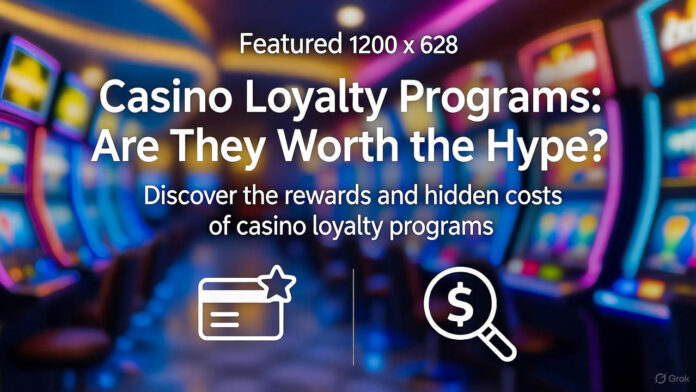In the glittering world of casinos, where the promise of fortune beckons, loyalty programs have become a cornerstone of the gaming experience. These programs, designed to reward regular patrons, offer a range of perks, from free hotel stays to exclusive event invitations. But as the gaming industry evolves, a pressing question emerges: Are casino loyalty programs truly worth the investment of time and money? This article delves into the mechanics of these programs, their benefits, potential drawbacks, and whether they deliver meaningful value to players in 2025.
The Anatomy of Casino Loyalty Programs
Casino loyalty programs operate on a simple premise: the more you play, the more you earn. Most programs are tiered, with players accumulating points based on their spending or gameplay. These points can be redeemed for rewards such as free slot play, dining credits, or even luxury vacations. Major casino chains like MGM Resorts, Caesars Entertainment, and Wynn Resorts have robust loyalty systems, each with unique branding—think MGM Rewards, Caesars Rewards, or Wynn Red Card.
Typically, players earn points by wagering on slots, table games, or other casino offerings. For example, a slot machine might award one point per $5 wagered, while table games often have lower point accrual rates due to their lower house edge. As players climb tiers (e.g., from Silver to Gold to Platinum), they unlock increasingly valuable perks, such as priority check-in, VIP lounge access, or cashback offers.
In 2025, many programs have integrated digital platforms, allowing players to track points, redeem rewards, and receive personalized offers via mobile apps. Some casinos have also partnered with non-gaming brands, enabling members to earn points at restaurants, retailers, or even airlines, broadening the appeal of these programs. For instance, platforms like joy.link free kredit rm15 offer promotional credits that can complement loyalty program benefits.
The Allure of Rewards
The primary draw of casino loyalty programs is the tangible benefits they offer. For frequent players, these rewards can feel like a natural extension of their gaming experience. Common perks include:
- Comped Rooms and Dining: High-tier members often receive free or discounted hotel stays, meals, or show tickets, which can significantly offset vacation costs.
- Exclusive Events: Invitations to concerts, sporting events, or private parties are common for top-tier players.
- Cashback and Free Play: Many programs offer cashback or free slot credits, providing players with additional chances to win without spending more.
- Priority Services: Higher tiers often come with perks like priority check-in, dedicated concierge services, or faster withdrawals at online casinos.
For example, Caesars Rewards members can redeem points for experiences like a stay at Caesars Palace in Las Vegas or a cruise with Norwegian Cruise Line. Similarly, MGM Rewards has partnered with brands like Marriott Bonvoy, allowing points to be converted for use at non-casino properties. These partnerships make loyalty programs appealing to players who value flexibility.
Beyond tangible rewards, loyalty programs tap into a psychological appeal. The tiered structure creates a sense of achievement, encouraging players to spend more to reach the next level. This gamification of loyalty mirrors trends in other industries, from airline frequent flyer programs to retail rewards cards.
The Hidden Costs
While the perks are enticing, loyalty programs come with caveats that players must consider. The most significant is the cost of earning rewards. To accumulate meaningful points, players often need to wager substantial amounts. For instance, earning enough points for a free night at a luxury hotel might require thousands of dollars in slot play, far outweighing the reward’s monetary value.
Additionally, the house edge ensures that casinos maintain a mathematical advantage over players. A 2024 study by the American Gaming Association found that the average slot machine player loses approximately 5-10% of their wagered amount over time. This means that chasing loyalty points can lead to significant losses, especially for casual players who don’t gamble frequently enough to reach higher tiers.
Another concern is the fine print. Many programs have expiration dates for points, restrictive redemption policies, or blackout dates for comped rooms. For example, a free stay might be unavailable during peak seasons like New Year’s Eve or major sporting events. Some players also report that rewards feel less valuable over time, as casinos adjust point requirements or devalue perks in response to economic pressures.
Data privacy is another emerging issue. In 2025, as loyalty programs rely heavily on digital platforms, players share personal information that casinos use to tailor offers. While this personalization enhances the experience, it raises concerns about data security, especially after high-profile breaches in the gaming industry in recent years.
Who Benefits Most?
The value of casino loyalty programs largely depends on the player’s habits and goals. High rollers, who wager large sums regularly, stand to gain the most. For these players, comped suites, VIP services, and cashback can offset a portion of their losses, making the programs a worthwhile perk. For example, a high-tier MGM Rewards member might receive a complimentary weekend at the Bellagio, complete with dining credits and show tickets, which could be worth thousands of dollars.
Casual players, however, may find the rewards less compelling. A weekend gambler who spends $200 on slots might earn enough points for a buffet discount but is unlikely to reach tiers offering significant perks. For these players, the cost of earning rewards often outweighs their value, especially when factoring in gambling losses.
Geographic location also plays a role. Players living near casino hubs like Las Vegas or Atlantic City can more easily redeem rewards, while those in remote areas may struggle to justify participation unless they frequently travel to casino destinations.
The Future of Casino Loyalty Programs
As the gaming industry evolves, so do loyalty programs. In 2025, casinos are increasingly integrating technology to enhance the player experience. Artificial intelligence is being used to deliver hyper-personalized offers, while blockchain-based systems are emerging to ensure transparency in point tracking. Some casinos are also experimenting with gamified challenges, where players complete missions (e.g., playing specific games) to unlock bonuses. For example, promotions like joy.link free kredit rm15 showcase how casinos are blending digital incentives with traditional loyalty structures.
However, economic factors, such as inflation and rising operational costs, are prompting casinos to recalibrate their programs. Recent reports suggest that some operators are increasing the points required for rewards or scaling back on high-value perks like complimentary rooms. This trend has sparked debate among players, with some arguing that loyalty programs are becoming less generous.
Despite these challenges, loyalty programs remain a powerful tool for casinos to retain customers in a competitive market. With the rise of online gambling, many programs now extend to digital platforms, offering rewards for virtual casino play. This shift broadens the programs’ reach but also intensifies competition, as players can choose from a global array of gaming options.
Are They Worth It?
Ultimately, the worth of casino loyalty programs hinges on individual circumstances. For high rollers and frequent visitors to casino destinations, these programs can provide substantial value, offering perks that enhance the gaming experience and offset costs. However, for casual players, the pursuit of rewards may lead to overspending, with the house edge eroding potential benefits.
Before enrolling, players should carefully assess their gambling habits, read the program’s terms, and set clear budgets to avoid chasing points at the expense of financial stability. As with any loyalty program, the key is to enjoy the perks without falling into the trap of spending more than intended. In 2025, casino loyalty programs remain a double-edged sword—rewarding for some, but a costly gamble for others.
Conclusion
Casino loyalty programs are a fascinating blend of reward and risk, reflecting the broader allure of the gaming industry. For those who approach them strategically—understanding the costs, setting limits, and leveraging perks that align with their lifestyle—they can add genuine value to the casino experience. However, without careful consideration, these programs can entice players into spending beyond their means, chasing rewards that may not justify the investment. As the industry continues to innovate, players must stay informed and disciplined to ensure that loyalty programs enhance, rather than detract from, their enjoyment. In the end, the decision to participate comes down to a personal calculation: balancing the thrill of the rewards against the realities of the game.



